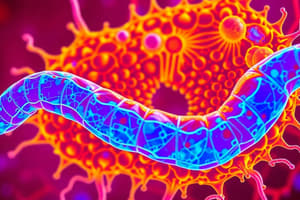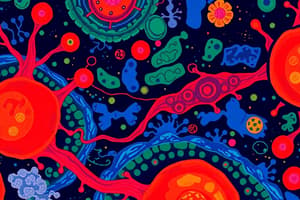Podcast
Questions and Answers
What distinguishes transmembrane proteins from peripheral proteins?
What distinguishes transmembrane proteins from peripheral proteins?
- Transmembrane proteins are always located outside the membrane.
- Transmembrane proteins can form α helices that cross the lipid bilayer. (correct)
- Transmembrane proteins do not interact with the lipid bilayer.
- Transmembrane proteins are involved in intracellular signaling only.
What is the primary function of porins in bacterial membranes?
What is the primary function of porins in bacterial membranes?
- To form channels for the passage of specific molecules. (correct)
- To mediate intracellular signaling.
- To facilitate DNA replication.
- To anchor cytoskeletal proteins.
Which statement about receptors in the plasma membrane is accurate?
Which statement about receptors in the plasma membrane is accurate?
- They are necessary for protein synthesis.
- They allow the cell to recognize chemical signals in the environment. (correct)
- They degrade excess proteins within the cell.
- They are exclusively glycoproteins.
The Golgi apparatus is primarily involved in which cellular process?
The Golgi apparatus is primarily involved in which cellular process?
Which technique is specifically used to locate proteins within cells?
Which technique is specifically used to locate proteins within cells?
What structural component of the Golgi apparatus is made up of 5 to 8 cisternae?
What structural component of the Golgi apparatus is made up of 5 to 8 cisternae?
What is indicated by the presence of multiple strands in a structure like bacteriorhodopsin?
What is indicated by the presence of multiple strands in a structure like bacteriorhodopsin?
In SDS-PAGE, what is the primary purpose of the technique?
In SDS-PAGE, what is the primary purpose of the technique?
What is the primary direction of movement for kinesin along microtubules?
What is the primary direction of movement for kinesin along microtubules?
What characterizes the structure of dyneins in terms of heavy and light chains?
What characterizes the structure of dyneins in terms of heavy and light chains?
Which component is crucial for the flexion of the axoneme in cilia and flagella?
Which component is crucial for the flexion of the axoneme in cilia and flagella?
Which protein undergoes glycosylation and is involved in the influenza virus?
Which protein undergoes glycosylation and is involved in the influenza virus?
What is a key role of Cell Adhesion Molecules (CAMs) in tissues?
What is a key role of Cell Adhesion Molecules (CAMs) in tissues?
Which of the following best describes the interaction mechanism between leukocytes and endothelial cells during extravasation?
Which of the following best describes the interaction mechanism between leukocytes and endothelial cells during extravasation?
What is the role of oligosaccharides in protein processing?
What is the role of oligosaccharides in protein processing?
Where does the phosphorylation of the mannose residue occur for lysosomal enzymes?
Where does the phosphorylation of the mannose residue occur for lysosomal enzymes?
Which transferase is specifically associated with the Trans-Golgi network?
Which transferase is specifically associated with the Trans-Golgi network?
What could be the consequence of a mutation replacing asparagine in protein HA?
What could be the consequence of a mutation replacing asparagine in protein HA?
What happens to non-glycosylated Fibronectin by fibroblasts?
What happens to non-glycosylated Fibronectin by fibroblasts?
What is the purpose of the mannose-6-phosphate (M6P) receptor?
What is the purpose of the mannose-6-phosphate (M6P) receptor?
What is a likely effect of antibiotic Tunicamycin on protein processing?
What is a likely effect of antibiotic Tunicamycin on protein processing?
Which type of adhesion molecule connects cells through homophilic interactions?
Which type of adhesion molecule connects cells through homophilic interactions?
What is the consequence of a genetic defect in β 2 Integrin synthesis?
What is the consequence of a genetic defect in β 2 Integrin synthesis?
Which of the following does NOT depend on Ca+2 for its function?
Which of the following does NOT depend on Ca+2 for its function?
GAP junctions primarily consist of which type of protein?
GAP junctions primarily consist of which type of protein?
Desmosomes are primarily associated with which class of adhesion molecules?
Desmosomes are primarily associated with which class of adhesion molecules?
What is the primary function of integrins in relation to the extracellular matrix (ECM)?
What is the primary function of integrins in relation to the extracellular matrix (ECM)?
What is a characteristic feature of collagen regarding its molecular structure?
What is a characteristic feature of collagen regarding its molecular structure?
What type of structural protein is laminin, and what is its primary role?
What type of structural protein is laminin, and what is its primary role?
Which of the following best describes the effect of a defect in the integrin cytosolic domain β subunit?
Which of the following best describes the effect of a defect in the integrin cytosolic domain β subunit?
Which statement about proteoglycans in the ECM is correct?
Which statement about proteoglycans in the ECM is correct?
In vertebrate tissue, what is the role of fibronectin?
In vertebrate tissue, what is the role of fibronectin?
What is a significant characteristic of collagen types I, II, and III in the extracellular matrix?
What is a significant characteristic of collagen types I, II, and III in the extracellular matrix?
What component exists as a cross-structured protein within the basal lamina?
What component exists as a cross-structured protein within the basal lamina?
What is the primary role of proteoglycans in the extracellular matrix?
What is the primary role of proteoglycans in the extracellular matrix?
Which statement best describes stem cells?
Which statement best describes stem cells?
What process describes the interaction between endothelial cells?
What process describes the interaction between endothelial cells?
Which of the following cell types are considered somatic cells?
Which of the following cell types are considered somatic cells?
What determines the fate of cell lineages?
What determines the fate of cell lineages?
What happens during terminal differentiation of a cell?
What happens during terminal differentiation of a cell?
What is a precursor cell?
What is a precursor cell?
What characterizes the process of cell lineage development?
What characterizes the process of cell lineage development?
Flashcards
Dynein movement direction
Dynein movement direction
Dynein motor proteins move towards the negative end of microtubules (MTs).
Kinesin movement direction
Kinesin movement direction
Kinesin motor proteins move towards the positive end of microtubules.
Cilia vs. Flagella
Cilia vs. Flagella
Cilia are short, hair-like structures; flagella are longer, whip-like structures, both involved in cell movement or fluid transport.
Cell Adhesion Molecules (CAM)
Cell Adhesion Molecules (CAM)
Signup and view all the flashcards
Extravasation mechanism
Extravasation mechanism
Signup and view all the flashcards
Membrane Proteins
Membrane Proteins
Signup and view all the flashcards
Integral Proteins
Integral Proteins
Signup and view all the flashcards
Peripheral Proteins
Peripheral Proteins
Signup and view all the flashcards
Porins
Porins
Signup and view all the flashcards
Receptors (Plasma Membrane)
Receptors (Plasma Membrane)
Signup and view all the flashcards
Golgi Apparatus
Golgi Apparatus
Signup and view all the flashcards
Cisternae
Cisternae
Signup and view all the flashcards
Dictiosomes (Golgi Bodies)
Dictiosomes (Golgi Bodies)
Signup and view all the flashcards
N-oligosaccharide modification
N-oligosaccharide modification
Signup and view all the flashcards
Protein glycosylation
Protein glycosylation
Signup and view all the flashcards
Tunicamycin effect
Tunicamycin effect
Signup and view all the flashcards
Mannose-6-phosphate (M6P)
Mannose-6-phosphate (M6P)
Signup and view all the flashcards
Lysosomal enzyme sorting
Lysosomal enzyme sorting
Signup and view all the flashcards
Protein stability and glycosylation
Protein stability and glycosylation
Signup and view all the flashcards
Non-glycosylated proteins
Non-glycosylated proteins
Signup and view all the flashcards
Trans-Golgi network (TGN)
Trans-Golgi network (TGN)
Signup and view all the flashcards
Types of cell adhesion
Types of cell adhesion
Signup and view all the flashcards
Cadherins
Cadherins
Signup and view all the flashcards
Desmosomes
Desmosomes
Signup and view all the flashcards
Gap junctions
Gap junctions
Signup and view all the flashcards
Leukocyte adhesion deficiencies
Leukocyte adhesion deficiencies
Signup and view all the flashcards
What are proteoglycans?
What are proteoglycans?
Signup and view all the flashcards
What is the role of fibronectin?
What is the role of fibronectin?
Signup and view all the flashcards
Mechanotransduction
Mechanotransduction
Signup and view all the flashcards
What is a stem cell?
What is a stem cell?
Signup and view all the flashcards
What is terminal differentiation?
What is terminal differentiation?
Signup and view all the flashcards
What are precursor cells?
What are precursor cells?
Signup and view all the flashcards
What are germ cells?
What are germ cells?
Signup and view all the flashcards
What are somatic cells?
What are somatic cells?
Signup and view all the flashcards
Connexin Family
Connexin Family
Signup and view all the flashcards
Heterodynamic Channels
Heterodynamic Channels
Signup and view all the flashcards
What do integrins do?
What do integrins do?
Signup and view all the flashcards
Platelet Function in Blood Clotting
Platelet Function in Blood Clotting
Signup and view all the flashcards
Collagen Structure
Collagen Structure
Signup and view all the flashcards
ECM Components
ECM Components
Signup and view all the flashcards
Laminin: Multiadhesive Protein
Laminin: Multiadhesive Protein
Signup and view all the flashcards
Fibronectin Structure
Fibronectin Structure
Signup and view all the flashcards
Study Notes
Exam Final 2024 Topics
- Plasma Membrane: A phospholipid bilayer with embedded proteins. It regulates what enters and leaves the cell. Includes components like lysosomes, peroxisomes, rough and smooth endoplasmic reticulum, centrioles, cilia, centrosome, cytoplasm, microvilli, mitochondrion, ribosomes, nucleoplasm, nucleolus, nuclear pores, and nuclear envelope.
Golgi Apparatus
- Structure: A series of flattened sacs (cisternae) with associated vesicles. Has distinct cis (forming) and trans (maturing) faces. Also has associated tubules.
- Functions: Glycosylation of proteins and lipids, protein modification, and packaging of secreted proteins into vesicles.
Cytoskeleton
- Actin Filaments (Microfilaments): Two-stranded helical polymers. Found in the cell cortex and involved in cell motility and contractility.
- Microtubules: Long hollow cylinders made of tubulin protein. Crucial for intracellular transport, cilia, and flagella.
- Intermediate Filaments: Rope-like fibers, composed of various intermediate filament proteins. Provide strength and mechanical support to cells. Keratin forms a large part of these fibers.
Extracellular Matrix (ECM)
- Composition: Composed of fibrous proteins (e.g., collagen, fibronectin), proteoglycans, and adhesive glycoproteins.
- Function: Provides structural support, regulates cell signaling and binds cells together.
Stem Cell/Apoptosis (Cell Birth, Lineage and Death)
- Stem Cells: Unspecialized cells that can self-renew and differentiate into specialized cell types.
- Apoptosis: Programmed cell death, a crucial process for tissue development and maintenance. Necrosis is the opposite, rapid lysis of the cell.
- Lineage: Series of cell divisions from stem cells to differentiated cells; there are distinct stages in this process.
Membrane Proteins
- Transmembrane Proteins: Proteins that span the membrane and mediate transport of substance. Examples include: ion channels, integrin dimers and Glycoproteins
- Peripheral Proteins: Proteins that sit on one side of the membrane interacting with membrane components indirectly only.
Chemical Basics
- Polar molecules: Soluble in polar solvents like water.
- Nonpolar molecules: Insoluble in water; aggregate together.
Phospholipids
- Amphipathic: Both polar and nonpolar regions
Fatty acids
- Saturated: No double bonds.
- Unsaturated: At least one double bond.
Other Components of Membranes
-
Glycoproteins: Carbohydrates attached to proteins, increasing their hydrophilicity and stabilizing their conformation in the membrane.
-
Glucolipids (Glycolipids): Carbohydrates attached to lipids, increasing their hydrophilicity.
Types of Membrane Proteins
-
Integral (Transmembrane): Domains that cross the membrane; mostly alpha helices or beta sheets.
-
Peripheral: Associated with one side of the membrane; may attach to membrane components.
Steroids
- Typical example is Cholesterol.
- They are amphipathic, with a hydrophilic region and a hydrophobic region.
Protein Classification (A.A)
- Nonpolar R groups: Hydrophobic
- Polar R groups: Hydrophilic
- Negatively Charged R groups: Hydrophilic
- Positively charged R groups: Hydrophilic
Erythrocyte Membrane
- Key structural proteins: Spectrin, Ankyrin, Actin, Tropomyosin, and Adducin, etc.
Bacteriodopsin and Porins
- Porins: Transmembrane proteins forming barrels that facilitate the passage of disaccharides and phosphates across the membrane.
- Bacteriodopsin: Contains multiple alpha-helices that cross the membrane; transmembrane protein.
Immunofluorescence (locating proteins inside the cell)
- Method to visualize proteins inside a living sample. Includes direct and indirect immunofluorescence.
Centrifugation Techniques
- Differential centrifugation: Separates cellular components based on size and density.
- Rate zonal centrifugation: Separates components based on density in a density gradient.
SDS-polyacrylamide Gel Electrophoresis (SDS-PAGE)
- Separates proteins based on size.
Estimating Protein Molecular Weight
- Using known molecular weight standards, plotting a graph of logarithm of molecular weight against relative migration allows estimating the unknown protein molecular weight.
Gel Filtration Chromatography
- Separates proteins based on size (large molecules elute first).
- Separates based on molecular size of protein.
- Separates by molecular size during the experiment
Antibody techniques
-
ELISA: Method for detecting and quantifying a specific protein using antibodies.
-
Western Blot: Method for detecting a specific protein using antibodies that detects a target protein of interest.
Immune response to blood groups
- Antigens and Antibodies. The specific reactions between them result in different blood types.
- Different blood groups based on their carbohydrate antigens.
Glycosylation
- Modifications of glycoproteins by carbohydrates in the endoplasmic reticulum and Golgi complex, which are important for stability and folding of proteins.
Processing of N-linked oligosaccharide chains
- Steps in enzymatic processes for modifying proteins using carbohydrates and their precursors
Modifications of N-oligosaccharides
- Localization of enzymes responsible for modifying N-oligosaccharides in the Golgi complex.
Structure of Axonemes of Cilia and Flagella
- Structure: Provides a basic picture demonstrating the different components of cilia and flagella to help understand their functions.
Dynein and Kinesin (Microtubule associated proteins) , Motor Proteins
- Kinesins: Motor proteins that move along microtubules towards the plus (+) end. Involved in anterograde transport (towards the cell periphery).
- Dyneins: Motor proteins that move along microtubules towards the minus (-) end. Involved in retrograde transport (toward the cell body) in vesicular traffic, ciliary muscles and cellular movements.
- Basic Structure of both proteins, particularly describing head, tails, and other structural regions associated with the proteins
Intermediate filaments
- Keratin and its involvement with the process of skin diseases (Epidermolysis bullosa simplex)
- Structural and other important characteristics(properties) of intermediate filaments.
Cytoskeleton II
- Microtubules, their role in intracellular transport through cilia and flagella, and their structure (tubulin protein forming hollow cylinders) along with basic functions. MTOC (Microtubules-Organizing Center) also known as the centrioles (pair of centrioles forming a structure that looks like a perpendicular 'L').
Dynamic Instability
- Dynamic instability (growth and shrinkage): property of microtubules, with processes of catastrophe and rescue.
Polarization of Epithelial Cells:
- Process by which epithelial cells develop a polarized structure, including apical and basement membrane (basolateral).
Mechanotransduction:
- The process in which physical forces applied to a cell translate into intracellular signalling pathways and cellular responses. How mechanical stress is communicated to the internal cell.
Golgi Apparatus
- Cis face: The receiving face/entry point of the Golgi.
- Trans face: The shipping/destination region of the Golgi.
Peroxisome
- Import system: Includes Pex proteins that direct proteins into peroxisomes.
Mannose-6-Phosphate (M6P)
- Targeting sequence: Directs enzymes to lysosomes through binding to M6P receptors.
Other routes of M6P
- Receptor-mediated endocytosis: How cells bring M6P-tagged proteins into the lysosomes, including the role of receptors, vesicles, clathrin, etc.
Proteoglycans
- Composition: Multiple glycosaminoglycans linked to a core protein. Form a network in cartilage, etc.
Fibronectin
- Structure and Function.
Collagen
- Composition, including the triple helix and its importance in the extra-cellular matrix.
- Molecular structure of collagen type IV (basal lamina)
Cell Birth, Lineage, and Death
- Overview of cell birth from symmetric and asymmetric cell divisions, and how these processes influence cell lineages.
Apoptosis
- Morphological changes and role of proteins during the process of apoptosis.
Studying That Suits You
Use AI to generate personalized quizzes and flashcards to suit your learning preferences.




